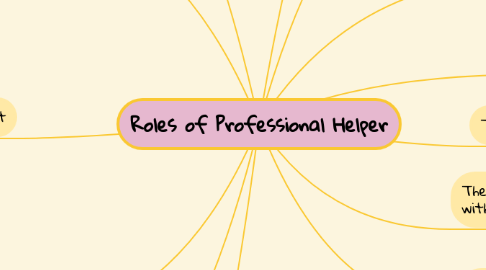Roles of Professional Helper
von Walid Khan

1. The Uniqueness and Characteristics of a Therapeutic Relationship
1.1. 1,Mutual liking or respect 2.The resolution of the client’s issues 3.Teamwork 4.Contract specifying 5.Understanding each other 6.Contractual relationship
1.2. what clients may say about helper
1.2.1. 1.taught me technique 2.Showed affections 3.Good listening behaviour 4.Disclosed matters 5.Emphasized
2. Roadblocks to communication
2.1. 1..ORDERING, DIRECTING, COMMANDING 2.WARNING, THREATENING 3.MORALISING, PREACHING 4.ADVISING, GIVING SOLUTIONS 5.JUDGING, CRITICISING, LAMING
3. Vital roles to play
3.1. 1.Make them peierce that they are not the only one who's facing the same problem 2.Understand themselves better and get a broader perspective 3.Observe others working through their problems or see models
4. Dealing with Diverse client
4.1. 1.Recognize they may hold attitudes and beliefs that influence their perceptions 2.Recognize the important of multicultural sensitivity/responsiveness, knowledge and understanding 3.Educators, encourages employ the constructs of multiculturalism and diversity in education 4.Recognize the importance of conducting culture-centered and ethical psychological research
5. Multiicultural Terminology
5.1. 1.Cultural diversity- differences in race, ethnicity, nationality, religion, gender, sexual identity 2.Stereotype- oversimplified and uncritical generalizations about individuals who are identified as belonging to a specific group 3.Cultural empathy- awareness of their own personal biases 4.Ethnicity- Beliefs, values, customs, or practices of specific group 5.Discrimination- act of treating a person, issue or behavior unjustly or inequitably as a result of prejudices
6. Ways to Facilitate Communication Across Cultural Boundaries
6.1. 1.Recognize differences 2.Build your self-awareness 3.Describe and identify, then interpret 4.Don’t assume your interpretation is correct 5.Verbalize your own non-verbal signs 6.Share your experience honestly
7. The stages a helper have to cop with
7.1. 1.The dualistic or right/wrong stage 2.the multiplistic Stage 3.The relativelistic Stage
8. Expectations from Helper
8.1. 1.Unrealistic Belief 2.Resaonable expectation
9. Understanding Culture competence
9.1. 1.Individuals from minority groups can be significant 2.Understanding and appreciating a clients’ cultural background expand treatment/intervention opportunities 3.Enhancing the sensitivity and capacity to treat clients from other cultures improves ability to treat/assist all client
10. Cultural differences
10.1. 1.Family is defined differently by different cultures 2.Some cultural groups stress respect for family 3.Eye contact varies by culture. 4.Physical distance during social interaction varies by culture.
11. Understanding the stages of cultural competence
11.1. 1: Cultural Destructiveness 2: Cultural incapacity 3: Cultural blindness 4: Cultural Pre competence 5: Cultural proficiency
12. How to be a Good Listener
12.1. 1.Smile and look interested 2.Be patient 3.Listen carefully and don’t interrupt
13. Types of helper
13.1. a) Non-professionals b) Paraprofessionals c) Professionals



